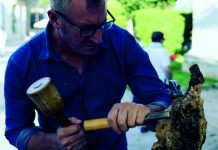Several weeks ago whilst walking on the drive at our Finca in Competa campo I noticed a shiny object half submerged in the chino that turned out to be a campaign medal inscribed FOR WAR SERVICE MERCANTILE MARINE.1914 1918.
Intrigued by this description and curious as to the nature of this service which I had
never come across before , I consulted the Wikipedia site and found out that 133,135 of these medals were awarded to civilians who served their country at sea
in World War 1. To qualify for this medal these peacetime mariners as they came to be called, had to have served at least 6 months at sea between 1914 and 1918 or
/and have sailed into at least one danger zone in this time.
Their numbers included men and women who worked in coastal occupations such as fishing, piloting ships or lighthouse keeping. Post Office cable ship crews could also qualify as did a lady called Minnie Mason who operated the Channel ferries
during the war. These medals were issued by the Board of Trade in 1919 and awarded by King George V whose profile is shown on the distaff side of the medal, the face illustrating ships at sea and a U- boat sinking in the waves. (Notice the
bubbles in the water).
Made of bronze, 36 mm in diameter each medal was attached by a single claw-foot to a ribbon bar 32 mm long and 13.5mm wide, patterned with vertical strips of red, white and green to represent the running lights on a ship but unsurprisingly after 101 years no longer attached to this medal.
Each medal had the recipient’s name impressed on the rim in Sans-serif capital letters, my mystery medal having been awarded to one Arthur Platt. My
search found 3 possible Arthur Platts on Ancestry sites and thought that given the available information, the likeliest candidate was Arthur Johnson Platt who was born in 1902 and who served as a steward on board a liner bound for America. The ship was torpedoed in 1917 and 15 year old Arthur was one of the survivors. .
During WW2 Arthur served in The Merchant navy formed in 1928 and was torpedoed a further three times, one each occasion showing exceptional bravery,
courage and a sense of duty according to an article in The Liverpool Echo dated January 3 1945. Was he lucky or unlucky?
So there you have it, the medal story explained and its original owner possibly identified, but the mystery still remains as to how a British service medal awarded
over a century ago ended up on the drive of a property in Competa? Any ideas anyone?
Although many of these medals turn up on EBay, I believe this one to be the genuine thing because the name on the rim would be surely hard to counterfeit so Arthur Platt I salute and thank you for your courage and bravery, a hero indeed.
By Jesamy Robinson




















